Discover 11 hidden attractions, cool sights, and unusual things to do in Focșani (Romania). Don't miss out on these must-see attractions: Nativity of St. John the Baptist Church, Săpunaru Church, and Donie Church. Also, be sure to include Church of the Prophet Samuel in your itinerary.
Below, you can find the list of the most amazing places you should visit in Focșani (Vrancea).
Table of Contents
Nativity of St. John the Baptist Church
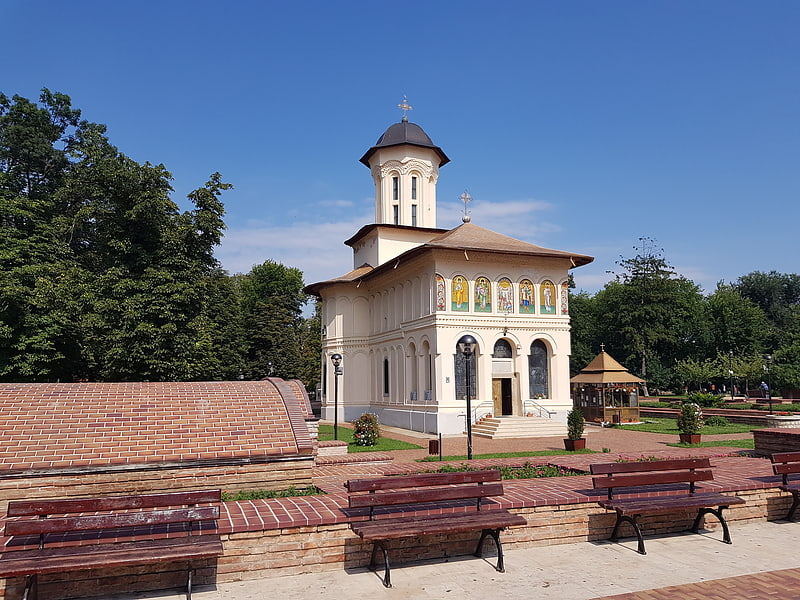
The Nativity of St. John the Baptist Church is a Romanian Orthodox church located at 5 Piața Unirii in Focșani, Romania. It is dedicated to the Nativity of Saint John the Baptist.
The church was founded by Grigore I Ghica, Prince of Wallachia, in 1661; the Ghica family would continue to provide support. Originally a monastery church, it is cross-shaped, made of brick and limestone on a stone foundation, in Byzantine style. On the interior, it is 22.40 meters long, 6.50 meters wide and 9.50 meters high. The floor is of stone blocks. The attached porch, of uncertain date, is around 4 meters long.
The monastery was a cultural and religious center, offering theological training and preparing a large number of monks, priests and deacons. In 1849, it possessed 22 books in Greek and 24 in Romanian Cyrillic. Until the 1863 secularization of monastic estates in Romania, it was a metochion of Agia Anastasia Monastery in Thessaloniki.
The monastery had the appearance of a fortress, surrounded by granite walls over 6 meters thick. On the inside, it had buildings with two stories that included 36 living apartments and 10 basements. It also had towers with embrasures, useful for positioning firearms. One of the wealthiest churches in the area, it owned several villages, estates, vineyards in Odobești, forests, stores and houses in Focșani. It acquired these both through donation and seizure without deed of state land. The wealth and power of the Greek monks stirred resentment among the town inhabitants and conflict with the local administration. Around 1850, following numerous petitions to the royal court, Princes Gheorghe Bibescu and Barbu Dimitrie Știrbei finally asserted control over the monks.
Over the years, the church suffered damage from earthquakes, the devastating 1854 fire, pillage by Ottoman troops during the reign of Constantine Mavrocordatos and by Filiki Eteria forces during the Wallachian uprising of 1821. After the 1854 fire, the monastery lost its majestic appearance. In 1871, the ruined walls were auctioned off to a Jewish merchant. Subsequently, of the old complex, the only remaining components are the church and bell tower, which sits in front. Located near a border post, the church witnessed important events surrounding the 1859 union of the Principalities, including the first Te Deum for national unity held on the square in front of the church, a "Hora Unirii" danced by domnitor Alexandru Ion Cuza, and military marches starting with Romanian independence in 1877.
The church is listed as a historic monument by Romania's Ministry of Culture and Religious Affairs, as is the 1839 tower.[1]
Address: 5 Piața Unirii, Focșani
Săpunaru Church
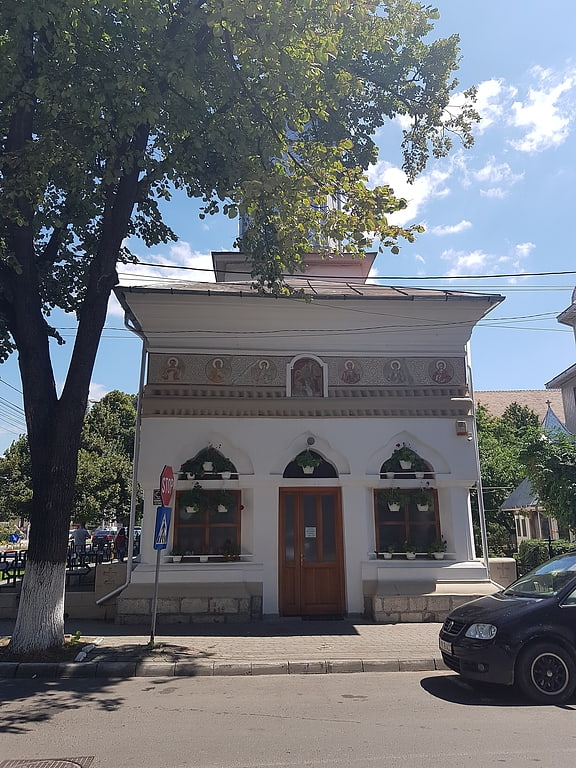
The Săpunaru Church is a Romanian Orthodox church located at 1 Simion Bărnuțiu Street in Focșani, Romania. It is dedicated to the Nativity of the Theotokos.
Located in the city center, the church dates to 1783. It was jointly financed by guild members: soap makers, chandlers, jacket makers and furriers. Among the main ktetors was Dima Săpunaru (“soap maker”). The building appears on the map drawn by the Austrian General Staff during the Austro-Turkish War (1788–1791).
Built of stone and masonry, the church is trefoil shaped. The initially open porch has three-lobed arches sustained by masonry pillars. The facade is on two registers of bricks, separated by a strongly accented row that surrounds the building above the windows. The interior features semi-spherical vaults.
The church is listed as a historic monument by Romania's Ministry of Culture and Religious Affairs.[2]
Address: 1 Strada Simion Bărnuțiu, Focșani
Donie Church
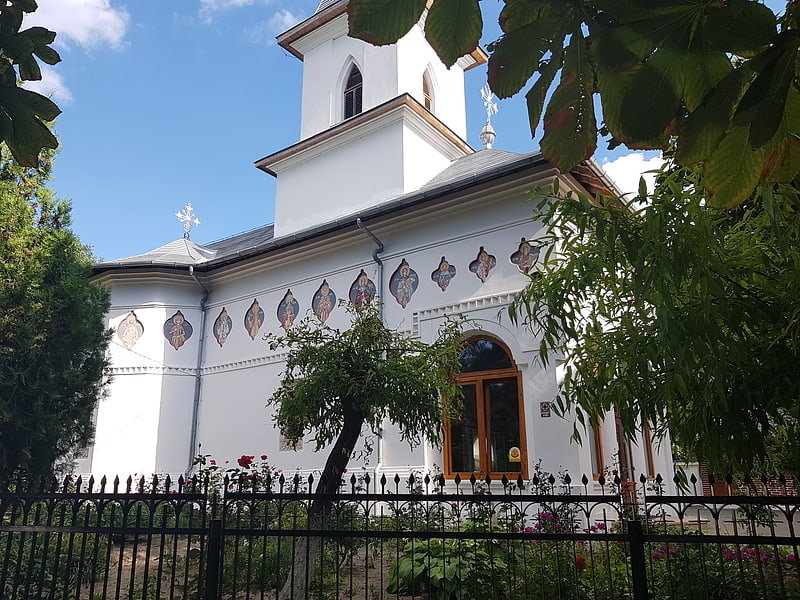
The Donie Church is a Romanian Orthodox church located at 6 Maior Gheorghe Pastia Street in Focșani, Romania. It is dedicated to the Dormition of the Theotokos.
The church is named after its ktetor, a Captain Donie of the border guards. It is trefoil in shape, with an originally open porch, a narthex, nave and altar. The porch initially featured semicircular arches resting on round stone columns. The facades are divided into two registers by a row of bricks above the windows. The area under the roof is slightly profiled, and features a row of cloverleaf-shaped recesses painted with saints’ portraits. The windows are surrounded by stone frames richly decorated with plant motifs.
The church is listed as a historic monument by Romania's Ministry of Culture and Religious Affairs, which supplies a construction date of 1708–1712.[3]
Church of the Prophet Samuel

The Church of the Prophet Samuel is a Romanian Orthodox church located at 28 Mare a Unirii Street in Focșani, Romania. It is dedicated to the Prophet Samuel.
The church ktetor was Constantin Racoviță, Prince of Moldavia; it was built in 1756 on land donated by a painter. The Chronicles of the Land of Moldavia mention an earlier wooden church on the site. The church gradually became part of a monastery complex, surrounded by a stone wall. In 1789, it offered shelter to Russian and Austrian troops during the Austro-Turkish War (1788–1791).
The cross-shaped church, in Wallachian style, has a porch, narthex, nave and altar. The square spire sits atop the porch. It is decorated with semicircular arches around its windows, and is accessed by a wooden staircase. The facades are divided into two registers by a row of stone. The lower section is decorated with three-lobed arches and columns. The upper features rectangular frames with circles inside. The door stands out in sharp relief.
The church and its wall are listed as historic monuments by Romania's Ministry of Culture and Religious Affairs.[4]
Address: 28 Strada Mare a Unirii, Focșani
Stroe Church
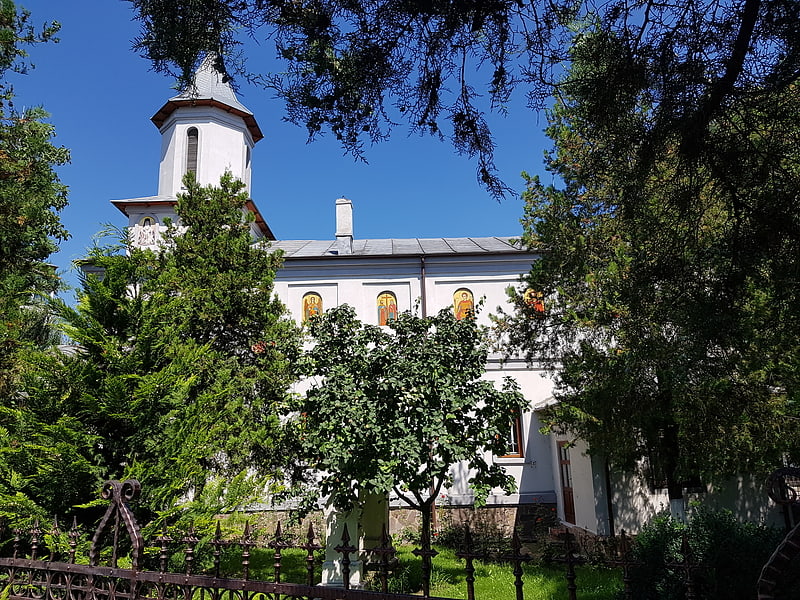
The Stroe Church is a Romanian Orthodox church located at 13 Duiliu Zamfirescu Street in Focșani, Romania. It is dedicated to Saint Nicholas.
The church was built in 1839. It is listed as a historic monument by Romania's Ministry of Culture and Religious Affairs.[5]
New St. Nicholas Church
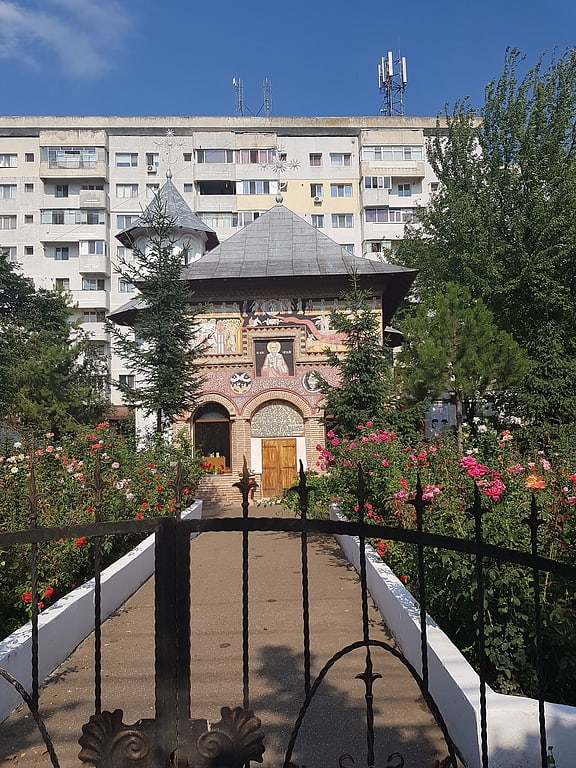
The New St. Nicholas Church is a Romanian Orthodox church located at 7 Popa Șapcă Street in Focșani, Romania. It is dedicated to Saint Nicholas.
The church is situated at the border between two former estates, and was founded by vassals of the Princes of Wallachia. It was mentioned as a monastery in 1694, originally a wooden church from the 1680s. That structure burned in 1732, and was rebuilt the same year. Paharnic Constantin Năsturel paid for the new structure, made of thick brick with a porch.
The interior was painted after 1746, with the ktetors appearing on the south wall. Various donors financed later expansions, including a lot for the parish house and a large bell. As of 1819, the parish was considered among the best maintained and endowed in the Buzău Diocese.
The church features a trefoil shape, with polygonal apses and a westerly porch. The bell tower is adjacent to the north wall of the narthex, on its exterior. The upper part of the tower is hexagonal, with its own roof. The porch, initially open, has stone columns supporting semicircular arches. Further columns and arches separate the narthex and nave. The facade is in two registers of brick, divided by a projecting row. The window frames are carved with plant motifs.
The church is listed as a historic monument by Romania's Ministry of Culture and Religious Affairs.[6]
Address: 7 Strada Popa Șapcă, Focșani
Old St. Nicholas Church
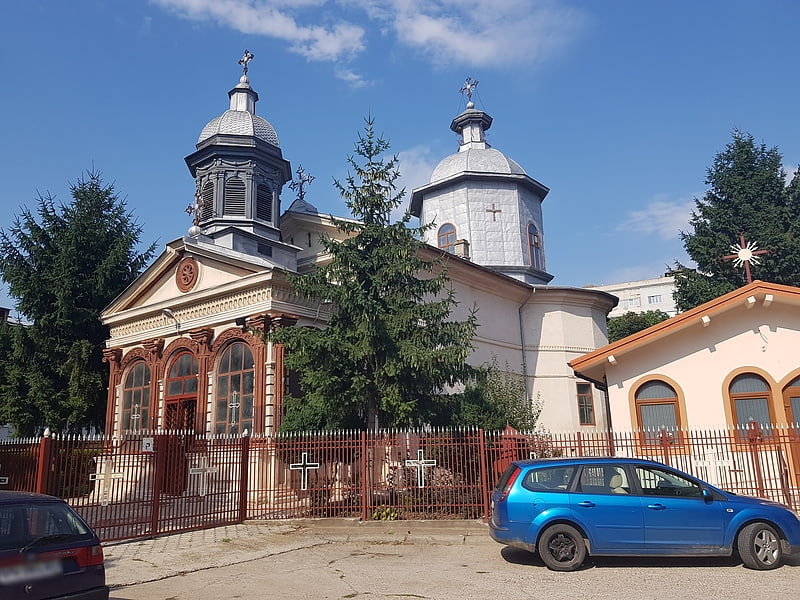
The Old St. Nicholas Church is a Romanian Orthodox church located at 1 Cotești Street in Focșani, Romania. It is dedicated to Saint Nicholas.
The church was built between 1713 and 1716. It is listed as a historic monument by Romania's Ministry of Culture and Religious Affairs.[7]
Address: 1 Strada Cotești, Focșani
Focșani Military Chapel
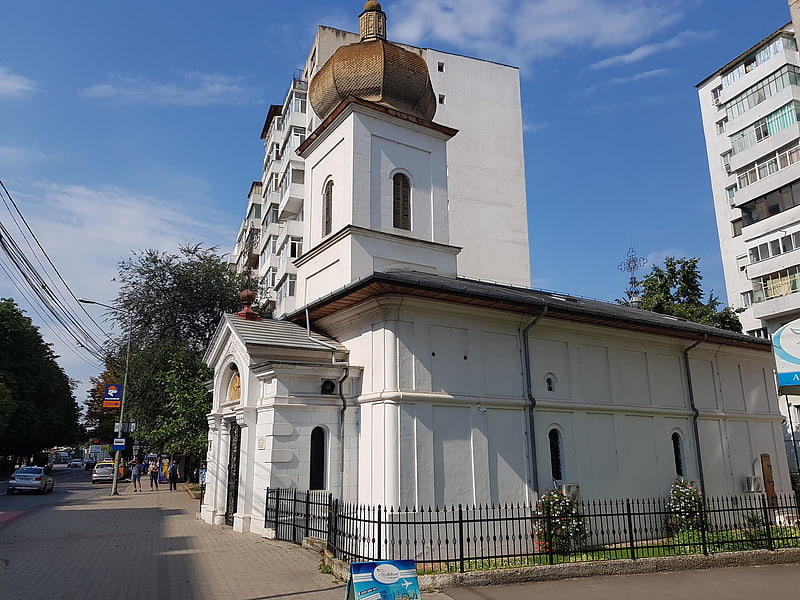
The Focșani Military Chapel is a Romanian Orthodox church located at 22 Unirii Boulevard in Focșani, Romania. Nowadays, it is a parish church dedicated to Saints Constantine and Helena.
The church is located in the Wallachian part of the city, on the site of a well ordered installed in 1696 by Prince Constantin Brâncoveanu. In 1810, Serdar Costache Robescu laid the cornerstone for what would become known as the Robescu Church, adjacent to his mansion. Despite the family’s patronage, it had become a ruin by the end of the 19th century. The 1838 Vrancea earthquake cracked the spire, while an 1854 fire damaged the church and the adjacent building which housed liturgical objects.
In 1893, the Robescu heir of the day donated the ruined church and annexes to the local military garrison, together with 6000 lei for repairs. The War Ministry carried out a renovation, also using funds from donors and garrisoned troops. The building served as a military chapel from 1893 until 1948, shortly after a communist regime was established. The chapel suffered serious damage during the 1940 Vrancea earthquake. Repairs were carried out by soldiers between 1941 and 1943, in the midst of World War II; General Mihail Lascăr aided in the effort. The painting and decor were reconditioned under supervision by a military priest.
The carved wooden iconostasis dates to 1855; the icons date to that period, and to 1942-1943. In 1832, during the Regulamentul Organic period, the church welcomed Russian general Pavel Kiselyov with a liturgy. In 1917, the remains of Ecaterina Teodoroiu spent three days inside, while being transported to her native Târgu Jiu.
The church is ship-shaped, with a porch, narthex, nave and altar. The spire rises above the narthex. The building is recessed below street level by half a meter. The ktetors’ grave is in the narthex, covered by a marble tablet inscribed with their names and floral decorations. The facades are divided into repeating rectangular sections, separated by flat plaster columns. The entrance has a triangular pediment and plant motifs.
The church, dated 1815, and its 18th-century wall are listed as historic monuments by Romania's Ministry of Culture and Religious Affairs.[8]
North St. George Church
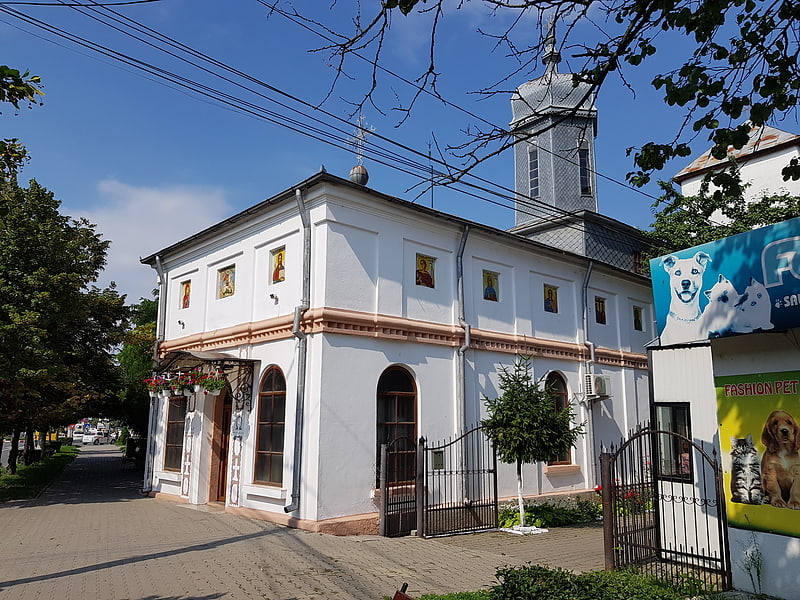
North St. George Church is a Romanian Orthodox church located at 20 Independenței Boulevard in Focșani, Romania. It is dedicated to Saint George.
The church was founded by the inhabitants of the Ocol quarter. A stone inscription on the floor indicates an 1819 construction date. The detached bell tower also served as an observation post for fires.
The ship-shaped church has a closed porch, a nave and altar. The foundation is stone, the walls of masonry. The porch and attic are linked by a wooden staircase on the north side. The nave is topped by a spire painted with Christ Pantocrator; it is cylindrical on the exterior, polygonal on the interior, with windows on each face. The facade is divided into two horizontal registers by a row of bricks. Each register is further divided into rectangular sections by columns. On the lower side, the columns enclose windows; on the upper, rectangular niches painted with saints’ portraits. The entry is protected by a glass and cast iron extension.
The church is listed as a historic monument by Romania's Ministry of Culture and Religious Affairs, as is the 1839 tower.[9]
Address: 20 Bulevardul Independenței, Focșani
Saint Demetrius Church
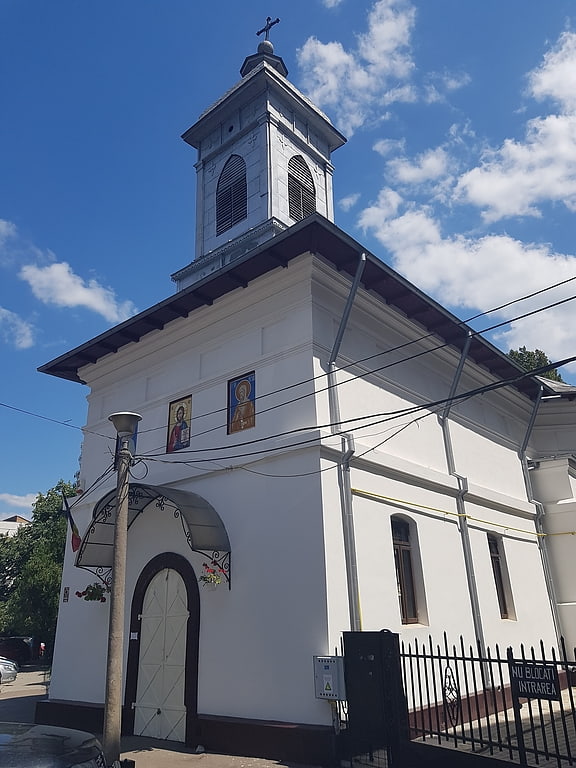
Saint Demetrius Church is a Romanian Orthodox church located at 4 Eroilor Street in Focșani, Romania. It is dedicated to Saint Demetrius of Thessaloniki, as well as to Anthony the Great.
The church was built on a plot of land donated by two brothers in 1692. First built in wood in 1696, it was rebuilt as a masonry structure in trefoil shape in 1709. The building is characteristic of the nascent Phanariot era, during which small-scale ktetors would donate for their spiritual and social benefit. A Captain Vicol financed construction.
When the church was placed under the supervision of the Agapia Monastery, the furious inhabitants of Focșani pillaged it. Tensions abated after the monastery leadership made several attempts to restore calm. Subsequently, in 1820, Veniamin Costache, the Metropolitan of Moldavia, took on the role of mediator between town and monastery.
By 1921, the church had degraded into a ruinous state, such that the city hall was considering demolition. Although saved from that fate following an appeal by parishioners, it was not until 1936 that a partial renovation took place, with further work in 1942 and 1968–1969. It came to be known as the Power Plant Church (Sfântul Dumitru - Uzină) due to the proximity of an electric station, demolished in 1978. The dedication to Saint Anthony was added in 1988, at the end of a six-year restoration.
The cross-shaped church is divided into a porch, narthex, nave and altar. The building material is masonry and limestone mortar. The porch features a closed balcony with carved wood. The neoclassical facades are horizontally separated by a sharply highlighted row of plaster. The upper register is decorated with square niches. The spire sits on the porch.
The church and is listed as a historic monument by Romania's Ministry of Culture and Religious Affairs.[10]
Ovidenia Armeni Church
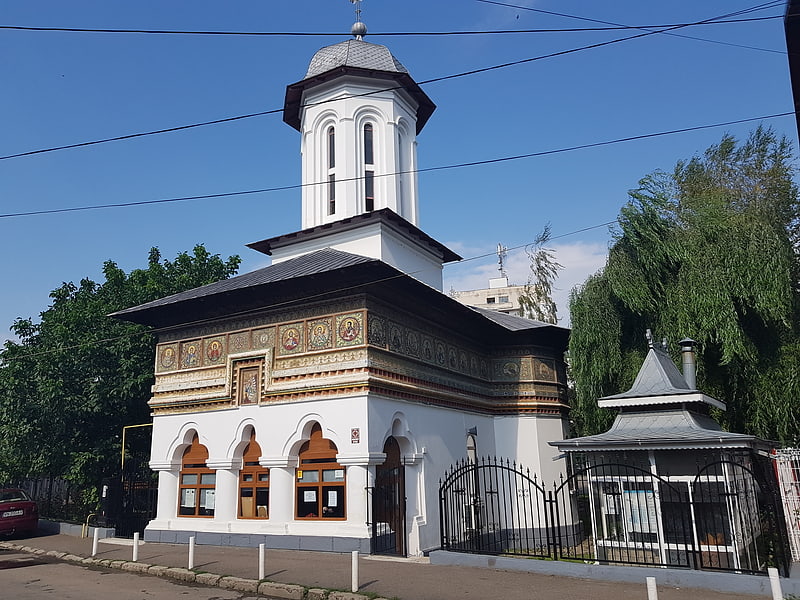
The Ovidenia Armeni Church is a Romanian Orthodox church located at 3 Făgăraș Street in Focșani, Romania. It is dedicated to the Entry of the Theotokos into the Temple.
The church dates to the end of the 18th century; construction appears to have lasted from 1789 to 1798. The ktetors are anonymous. It was once in the midst of an Armenian quarter. The church was seriously damaged and abandoned during World War I. After 1975, the communist authorities wished to demolish the ruins, but a priest convinced them to abandon the idea. The interior was painted from 1980 to 1985. The parish reopened in 1998.
The church is listed as a historic monument by Romania's Ministry of Culture and Religious Affairs.[11]